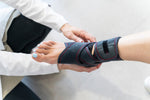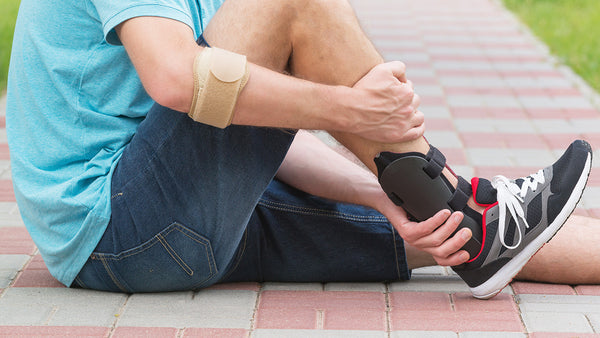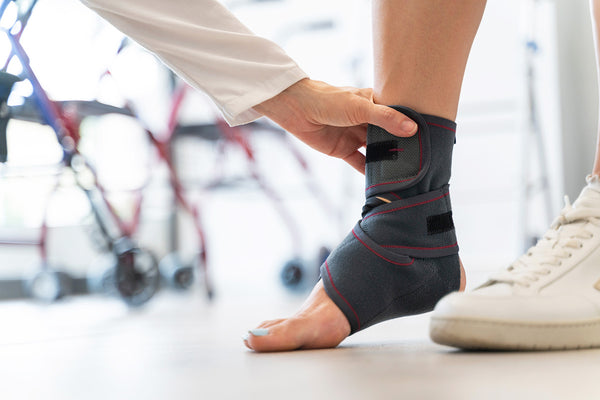
Your Guide to Wearing an Ankle Brace
, by OrthOut Writer, 10 min reading time

, by OrthOut Writer, 10 min reading time
This guide explains everything you need to know about wearing an ankle brace, including when to use one, the different types and levels of support, and how to effectively wear them for maximum comfort and support.
An ankle brace is a supportive garment you can wear around your ankle for extra support during injury recovery, or to reduce the likelihood of future injury. This guide explains everything you need to know about wearing an ankle brace, including when to use one, the different types and levels of support, and how to effectively wear them for maximum comfort and support.

Ankle braces offer valuable support in various situations, providing stability and promoting healing. Here are some key times when wearing an ankle brace might be beneficial:
Activities like running, jumping, and sports that involve quick changes in direction put significant stress on your ankles. An ankle brace can help prevent injuries by providing extra support and limiting excessive movement.
Following an ankle sprain, a brace can play a crucial role in the healing process. It helps reduce swelling, minimize pain, and restrict movement, allowing the injured tissues to heal properly. This can also be true for other ankle injuries like tendonitis or ligament tears.
It's important to note that wearing an ankle brace shouldn't replace proper rehabilitation following an injury. If you're unsure whether an ankle brace is right for you, consult a healthcare professional for personalized advice.
Some people may experience persistent ankle weakness or instability, making them susceptible to repeated sprains. An ankle brace can offer ongoing support and improve proprioception (body awareness) in the joint, reducing the risk of future injuries.

The duration of wearing an ankle brace depends on several factors, including the severity of your injury, activity level, and doctor's recommendation. For chronic instability, it’s best to consult a healthcare professional about a long-term wear plan.
After an ankle sprain or other acute injury, you can generally expect to wear an ankle brace for various amounts of time throughout the healing and rehabilitation process:
Remember, this information is for general guidance only. Always consult a healthcare professional for personalized advice on wearing an ankle brace, especially if you have any concerns or underlying medical conditions.
Nowadays, there are many different variations of ankle braces available to choose from. Selecting the best ankle brace for your needs is crucial for maximizing its effectiveness and comfort. One of the biggest factors to consider when choosing the best one for you is the level of support you require from an ankle brace:
For mild ankle sprains and injury prevention a mild-support brace like an ankle compression sleeve or an ankle wrap will help limit movement and reduce swelling, aiding in protection and healing.
Best suited for:
Ankle sleeves are a type of supportive wear typically made from stretchable materials. These lightweight sleeves provide gentle compression, improving circulation and promoting healing. For instance, the Incrediwear Ankle Sleeve utilizes a fabric blend woven with semiconductor elements that reduce inflammation and increase blood flow, which targets pain and swelling for recovery support. These sleeves are incredibly comfortable and durable, and can be worn with most shoes, so you can experience comfort all day.
An ankle wrap is a mild support brace with straps that wrap around the foot to provide a personalized fit and adjustable support. The design makes this type of ankle brace easy to put on, while a customized fit allows you to adjust throughout the day for maximum comfort.
The BioSkin Premium Ankle Wrap Brace is a great option for addressing ankle instability, swelling, and pain. This brace uses adjustable Velcro straps to ensure easy, pain-free application and a comfortable fit all day. It also comes with removable gel pads that can be frozen in the freezer for additional relief from cold therapy and is slim enough to fit snugly inside most shoes.
For moderate sprains or support during high-impact activities, a lace-up ankle brace or semi-rigid or hinged ankle brace may be the best option.
Best suited for:
Like a shoe, lace-up ankle braces are secured with laces. These adjustable braces offer good support by allowing customized tightness and compression. They offer a snug fit that prevents your ankle from rolling sideways while allowing for full forward and backward movement.
The Med Spec ASO ankle brace is a great example of a high-quality lace-up brace designed to support injury recovery while also reducing the chance of future harm from ankle rolls. Its unique lacing design allows you to make individual adjustments to your forefoot, mid foot, and ankle for maximum comfort and stability.
Hinged ankle braces provide support through a rigid hinge mechanism, restricting side-to-side movement while still allowing up-and-down motion. They offer a higher level of support than other types of braces and are often recommended for those who are recovering from moderate injuries.
For example, the Hely & Weber Hinged Ankle Brace is designed for individuals who require more than just standard support. Crafted with durability in mind, the ballistic nylon assembly helps the brace withstand the rigors of daily use, while the low-profile hinge provides you with the rigid support your ankle needs.
For severe sprains or post-operative support, a rigid high-stability ankle brace might be necessary. Maximum support ankle braces are designed to aid in recovery and help prevent further injury while still allowing for healthy movement.
Best suited for:
A stirrup ankle stabilizer is a maximum support brace with a semi-rigid shell that protects the ankle from re-injury. Typically used for severe sprains, chronic instability, or following major injuries, ankle stabilizers also provide support and compression for all-day protection and help with pain relief.
The Bird & Cronin SPRINT Ankle Stabilizer is a great brace for support and protection due to chronic instability or following a severe sprain. This ankle brace features a dual chamber design to accommodate lightweight gel liners and comfort foam materials for maximum support and optional cold therapy.

When wearing an ankle brace, there are several things you can do to increase your comfort. It’s important to note that depending on your reasoning for needing an ankle brace, your foot may swell throughout the day, so be prepared to adjust the tightness of the brace as needed.
Some of the best ways to maximize your comfort while wearing an ankle brace include:
Whether you’re recovering from an injury or looking for everyday support, finding the best ankle brace for your unique needs is important. At Orthopedic Outfitters, we have decades of experience offering the best orthopedic physical therapy equipment to both consumers and clinicians. Level up your wellness or recovery by exploring our selection of physical therapy products today.
Plus, you can enjoy FREE shipping for all orders over $50!